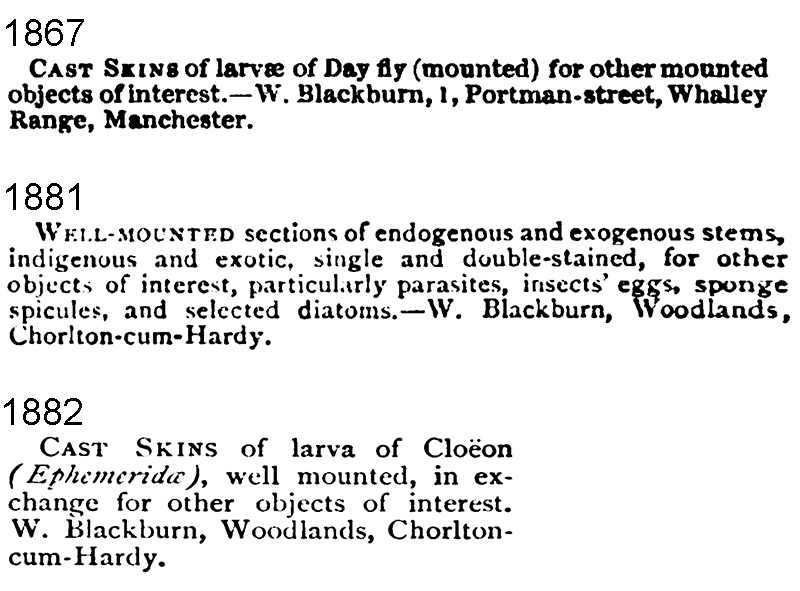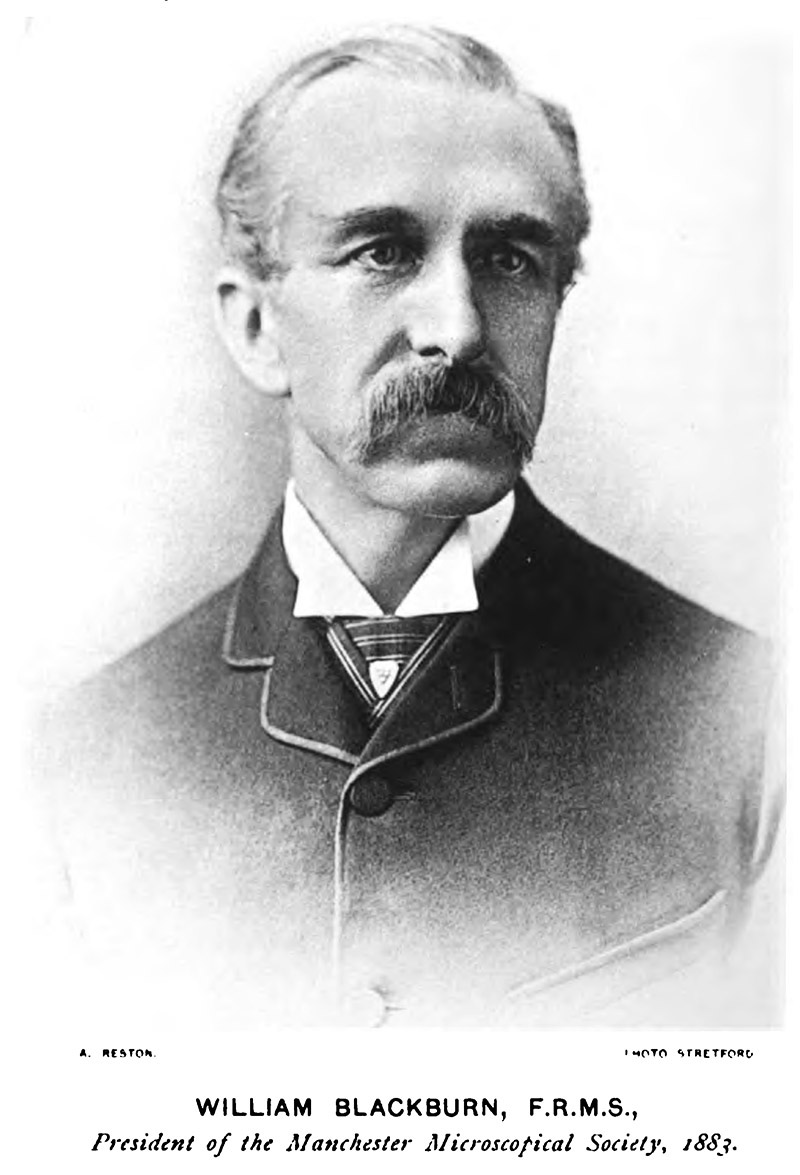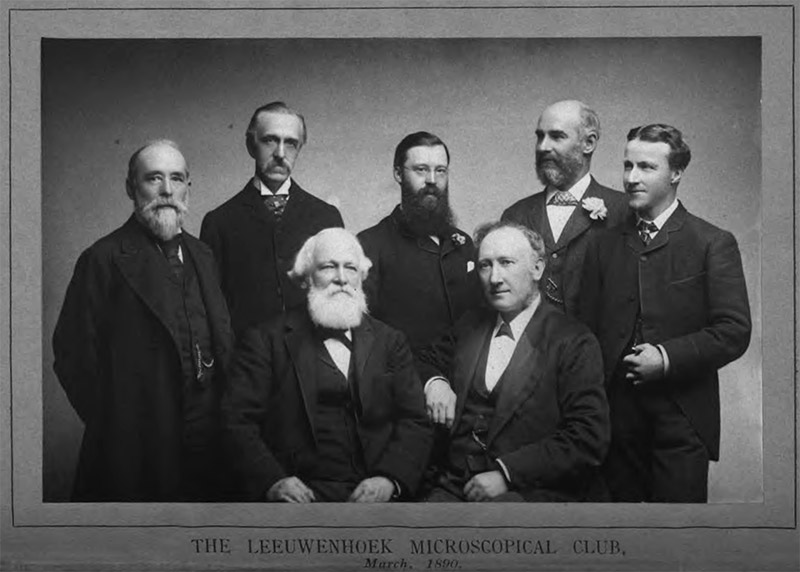William Blackburn, 1836 - 1908
by Brian Stevenson
last updated October, 2025
William Blackburn was a well-to-do heir of a timber business in Manchester, England. An expert microscopist, he joined the Royal Microscopical Society in 1881, and the Manchester Microscopical Society and the Leeuwenhoek Microscopical Club (Manchester) at around the same time. Other records indicate that Blackburn was already a skillful slide-maker by 1867. He served as President of the Manchester Microscopical Society in 1883, and was a long-time member of the Mounting Section.

Figure 1.
Microscope slides by William Blackburn. The slide on the right, cast skin of a larval Cloëon, was probably made ca. 1882, when Blackburn made two presentations on this insect to the MMS and advertised to exchange slides of it (see Figure 2). From the author's collection or adapted for nonprofit, educational purposes from an internet auction site.

Figure 2.
Exchange offers from William Blackburn, from "Hardwicke's Science-Gossip (1867 and 1881) and "The Microscopical News and Northern Microscopist" (1882).

Figure 3.
William Blackburn, from the 1889 "Transactions and Annual Report of the Manchester Microscopical Society".

Figure 4.
The Leeuwenhoek Microscopical Club, March 1890. Left to right, Mark Stirrup, William Blackburn, John Barrow, John Boyd, John Tatham, Charles Bailey, and John B. Pettigrew.
William Blackburn was born on March 3, 1836, in Manchester. Shortly afterward, he was baptized at Oxford Street Baptist Church. He was a son of Robert and Mary Blackburn. Father Robert was described in censuses as a "timber merchant".
The first identified evidence of William Blackburn's interest in microscope is an 1867 offer to exchange his prepared slides with other mounters (Figure 2). He was then 21, living with his parents and siblings in the Whalley Range suburb of Manchester.
The family had moved to Chorlton-cum-Hardy by the time of the 1871 national census. William was then recorded as working as an "accountant". Robert continued to live at the family home, "The Woodlands", until the turn of the twentieth century. William never married, but one or two of his unmarried sisters lived with him to keep the home. The Blackburns enjoyed the services of cooks and housemaids.
Father Robert died in 1873. Thereafter, William Blackburn was recorded in censuses as either "landed proprietor" or "living on own means", indicating that he lived from investment profits.
William joined the Royal Microscopical Society in 1881. It is not known whether he ever travelled to London to attend meetings. Around that same time, he also joined the Manchester Microscopical Society and the Leeuwenhoek Microscopical Club.
The Leeuwenhoek Microscopical Club was a predecessor of the Manchester Microscopical Society, and continued as a small club for many years after formation of the larger MMS. The Leeuwenhoek Club "limited its membership to just that number which its members could conveniently accommodate in each other’s house and seat around a common table; but, generally, at the meetings there has been room for one or two guests. There has never been a period when it could not have enlarged its borders; but a doubling of the number of its members would, in most cases, have proved inconvenient for accommodation in a private house, and would, besides, have consumed too much time in the examination of the suite of objects prepared to illustrate the special study of the evening. It has been found by experience that six or eight persons, with two or three microscopes revolving in order within the circle, make the happy medium for the most effective consideration and discussion of the many points which arise during the demonstration of any practical subject".
Of particular note, Blackburn made two presentations to the MMS in 1882 on larvae of Ephermeridae mayflies, in particular, of the genera Caenis and Cloëon. Both talks were published in The Northern Microscopist and Microscopical News in 1882. Not coincidentally, the magazine also carried offers from Blackburn to exchange his microscope slides of mayfly nymphs (Figures 1 and 2). That magazine noted that the mayfly nymphs were "a subject upon which (Blackburn) has devoted the past two years".
Blackburn was elected President of the MMS for 1883. His Presidential Address centered on the use of microscopes in medicine and science, and included recent information on bacteria and the germ theory.
Other talks by Blackburn indicate a wide range of interests, including structure of bone, physiology of an aquatic worm, and diffraction spectra.
MMS membership records indicate that Blackburn moved around the turn of the century to Aldeburgh House, Harrop Road, Hale (then in Cheshire). He died on September 4, 1908, at his then-home, "Woodlawn", on Belmont Road, Hale. He bequeathed his estate to two unmarried sisters.
His obituary in the Transactions and Annual Report of the Manchester Microscopical Society included, "His communications …, when read they never failed to evoke that interest which attends the recording of good work done in the many paths open to the Zoologist or Botanist, more especially (as in his case) they were described in the clearest language… When examining exhibits at our Soirees, his advice and suggestions as a practical microscopist were also of use, and some of us will long remember his words 'spoiled with too much light', for they conveyed a lesson but too often disregarded. It is interesting to remember that though he had never (as far as is known) taken a degree, his judicial bearing, all round knowledge in the varied domains of science, and the precise accuracy of his descriptions demanded from many of us the spontaneous homage, which we often unconsciously expressed by addressing or referring to his as Dr."

Figure 5.
Photomicrograph of tissue from Pennatula phosphorea (phosphorescent sea pen), prepared by William Blackburn (see Figure 1). Photographed with a 3.5x objective lens, with top lighting and crossed polarizing filters, with a digital SLR camera mounted on a Leitz Ortholux II microscope.
Resources
Baptism record of William Blackburn (1836) Church records of Oxford Street Baptist Church, Manchester, accessed through ancestry.com
Blackburn, William (1882) A nymph of the genus Caenis (family Ephemeridae), The Northern Microscopist and Microscopical News, Vol. 2, pages 53-58
Blackburn, William (1882) Remarks suggested by the study of the Ephemeridae, The Northern Microscopist and Microscopical News, Vol. 2, pages 62-65
Blackburn, William (1883) The President's Address to the Manchester Microscopical Society, The Northern Microscopist and Microscopical News, Vol. 3, pages 93-105
Blackburn, William (1883) The bacteriaceae, The Northern Microscopist and Microscopical News, Vol. 3, pages 166-170 and 185-191
Blackburn, William (1883) Spontaneous fission in an aquatic worm, The Northern Microscopist and Microscopical News, Vol. 3, pages 273-278
Blackburn, William (1885) Bone: It's structure, development, and growth, Transactions and Annual Report of the Manchester Microscopical Society, pages 33-38
Blackburn, William (1885) Diffraction spectra, Transactions and Annual Report of the Manchester Microscopical Society, pages 58-60
Blackburn, William (1889) The organisms of fermentation, putrefaction, and disease, Transactions and Annual Report of the Manchester Microscopical Society, pages 84-100
Blackburn, William (1908) Sponges and their life-histories, Transactions and Annual Report of the Manchester Microscopical Society, pages 61-63
England census and other records, accessed through ancestry.com
Hardwicke's Science-Gossip (1867) Exchange offer from William Blackburn, Vol. 1, page 264
Hardwicke's Science-Gossip (1881) Exchange offer from William Blackburn, Vol. 17, page 24
Journal of the Royal Microscopical Society (1889) Fellows, page xlv
The Northern Microscopist and Microscopical News (1882) Exchange offer from William Blackburn, Vol. 2, page 20
The Northern Microscopist and Microscopical News (1882) Manchester Microscopical Society, Vol. 2, page 71
Probate of the will of William Blackburn (1908) "Blackburn William of Woodlawn Belmont-road Hale Cheshire died 4 September 1908 Probate London 5 November to Sarah Jane Blackburn and Mary Blackburn spinsters. Effects £803 17s", accessed through ancestry.com
A Review of the Work of the Leeuwenhoek Microscopical Club, Manchester, From October, 1867, to March, 1891. in
Pamphlets on
Protozoology (Kofoid Collection), Vol. 298, page 323, , on line at http://books.google.com/books?id=jmA0AAAAIAAJ
Simon, L. (1908) Obituary: William Blackburn, Transactions and Annual Report of the Manchester Microscopical Society, page 83
Transactions and Annual Report of the Manchester Microscopical Society (1889) Frontispiece: portrait of William Blackburn
Transactions and Annual Report of the Manchester Microscopical Society (1899) Members
Transactions and Annual Report of the Manchester Microscopical Society (1905) Members




